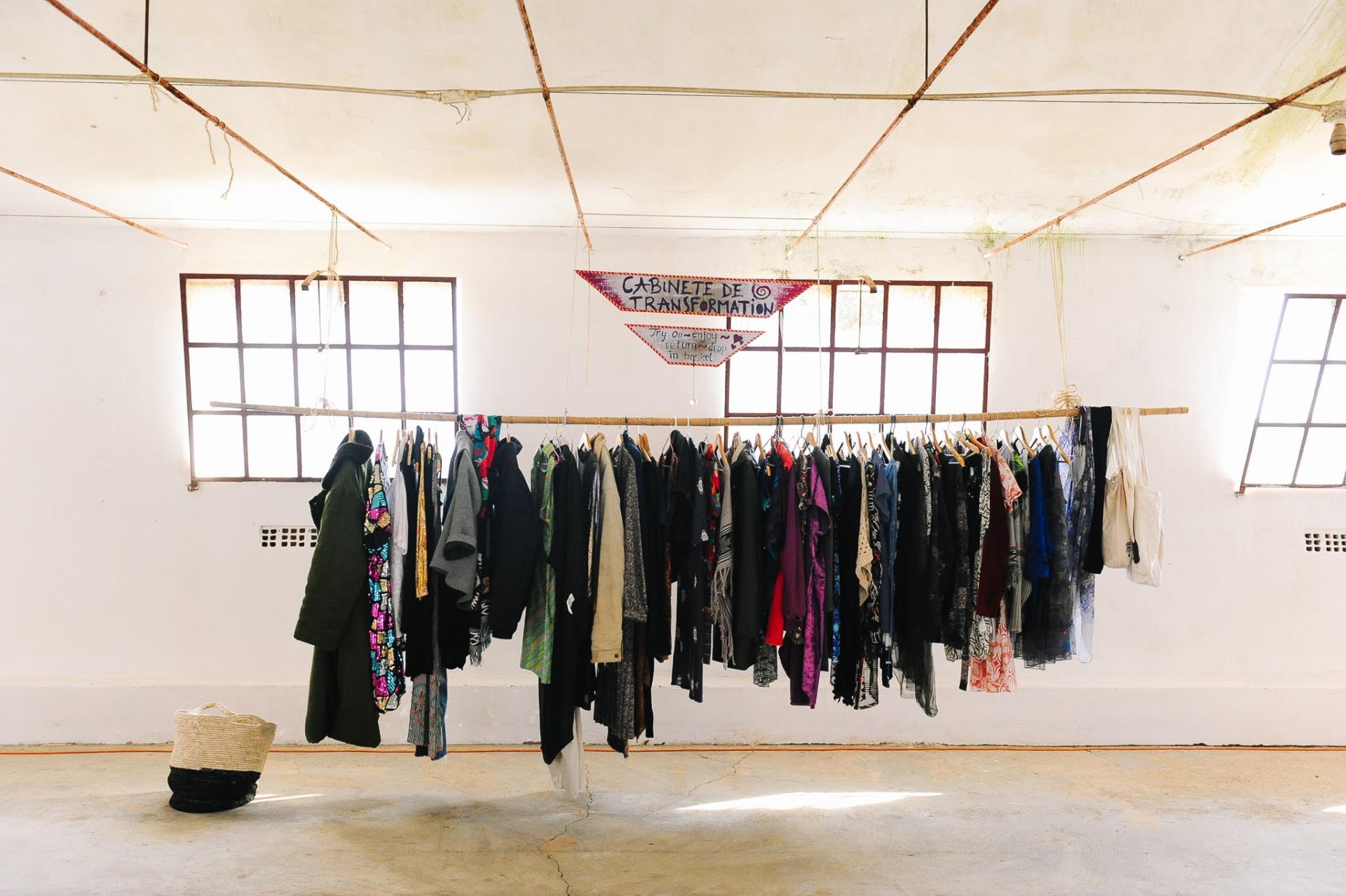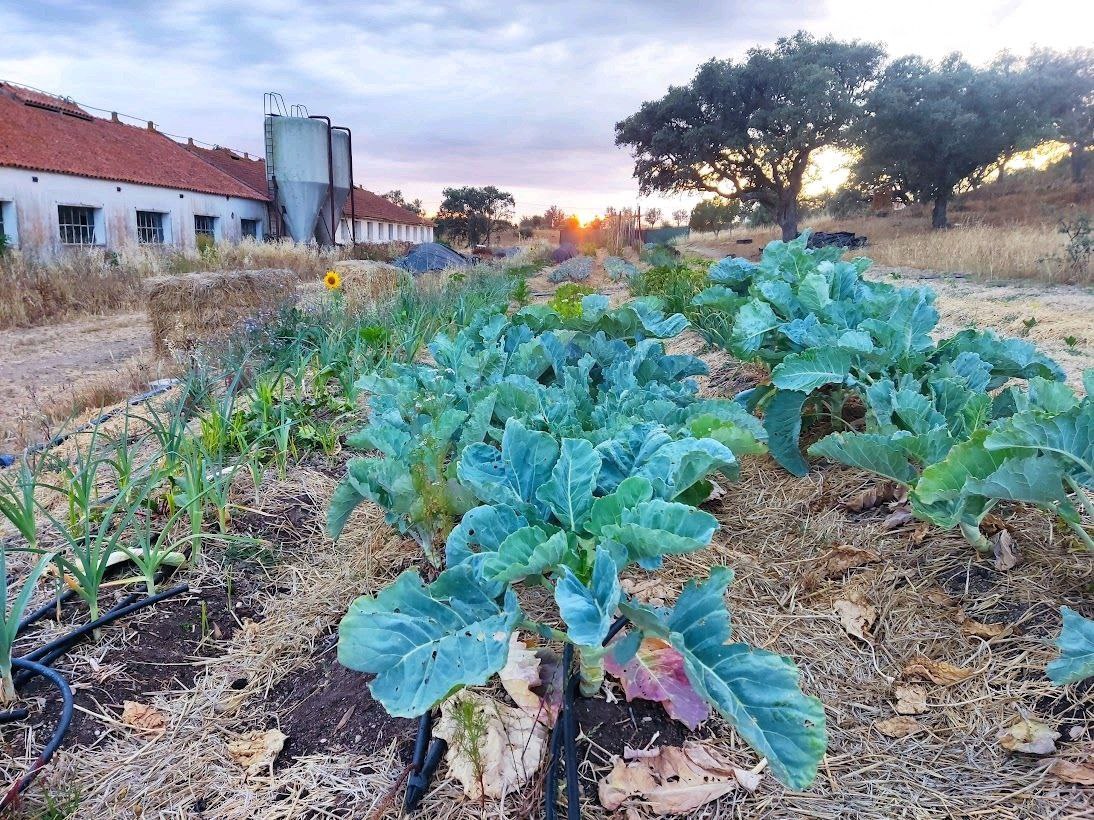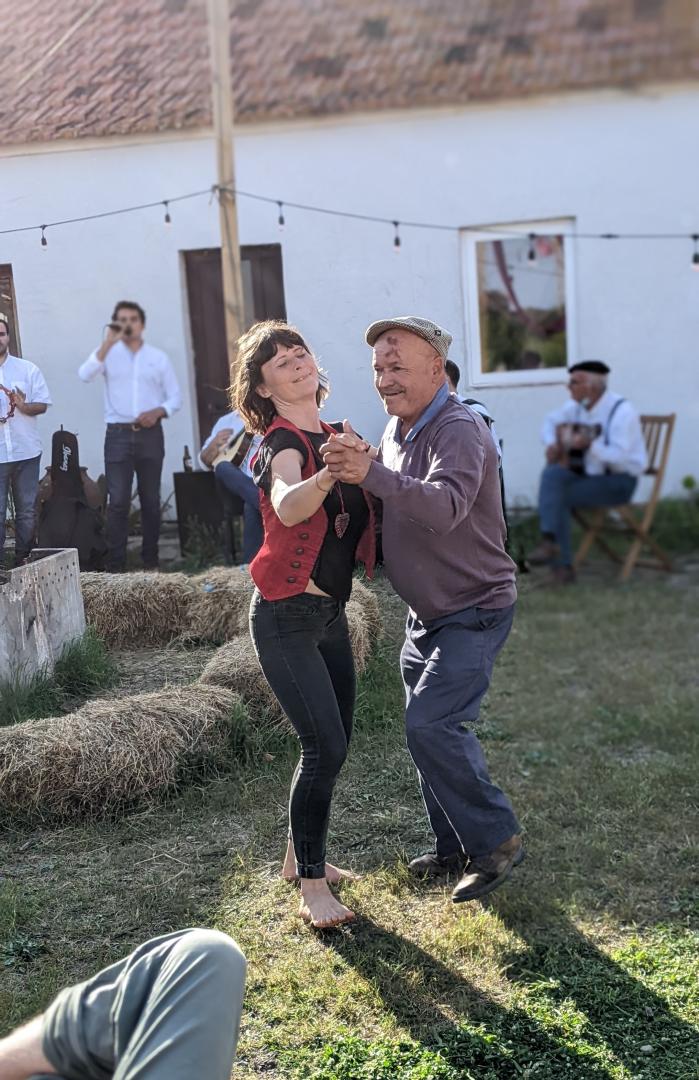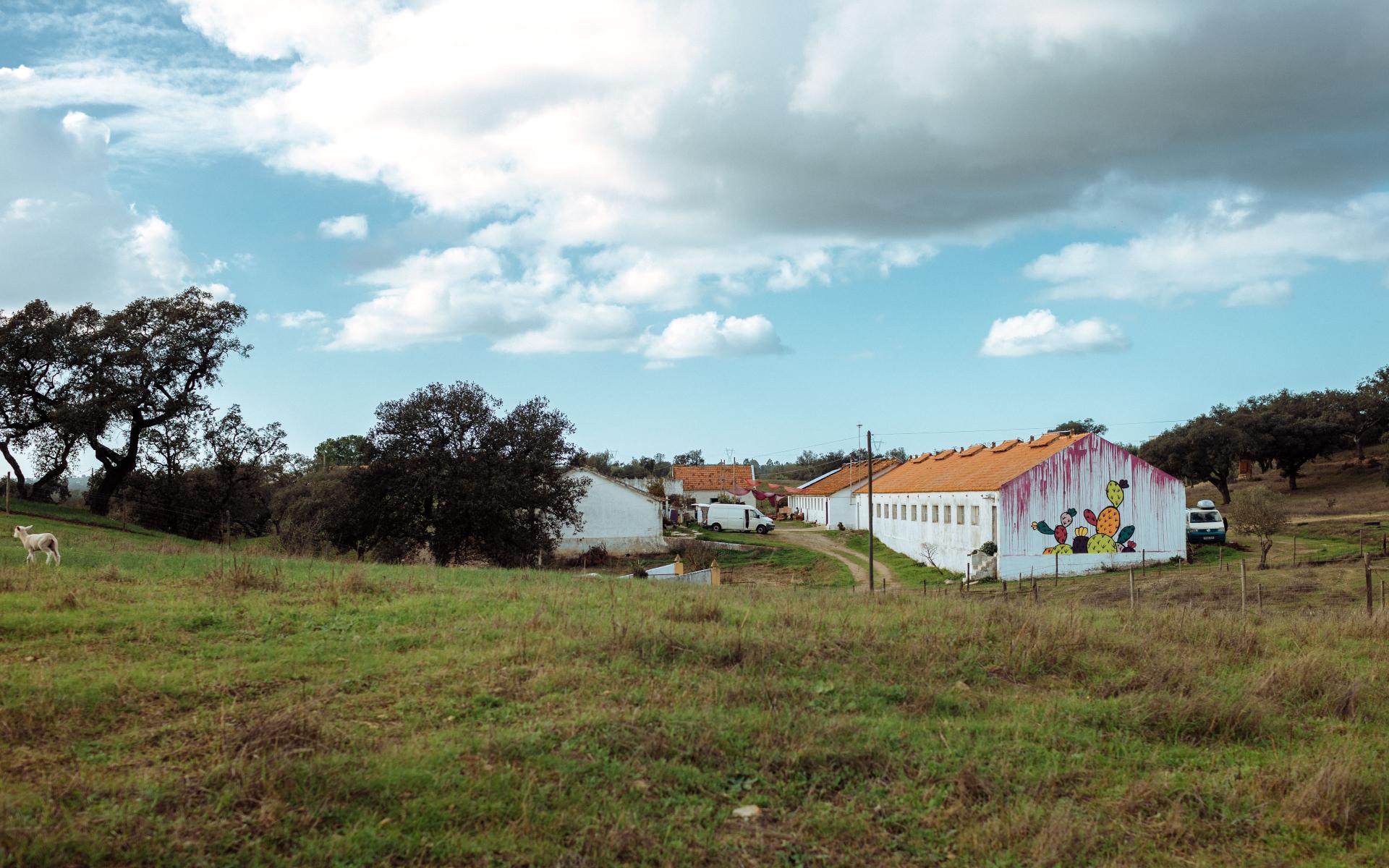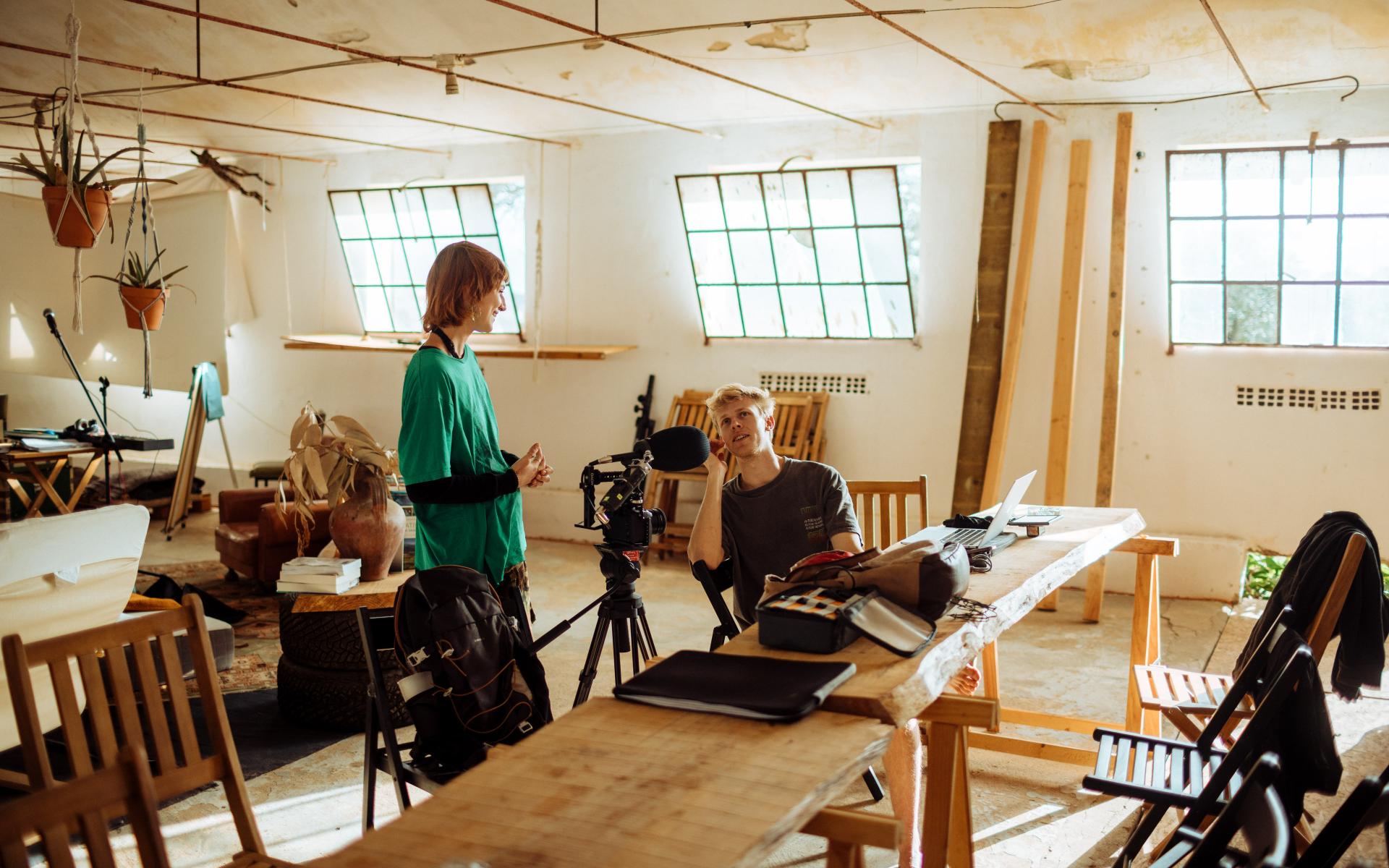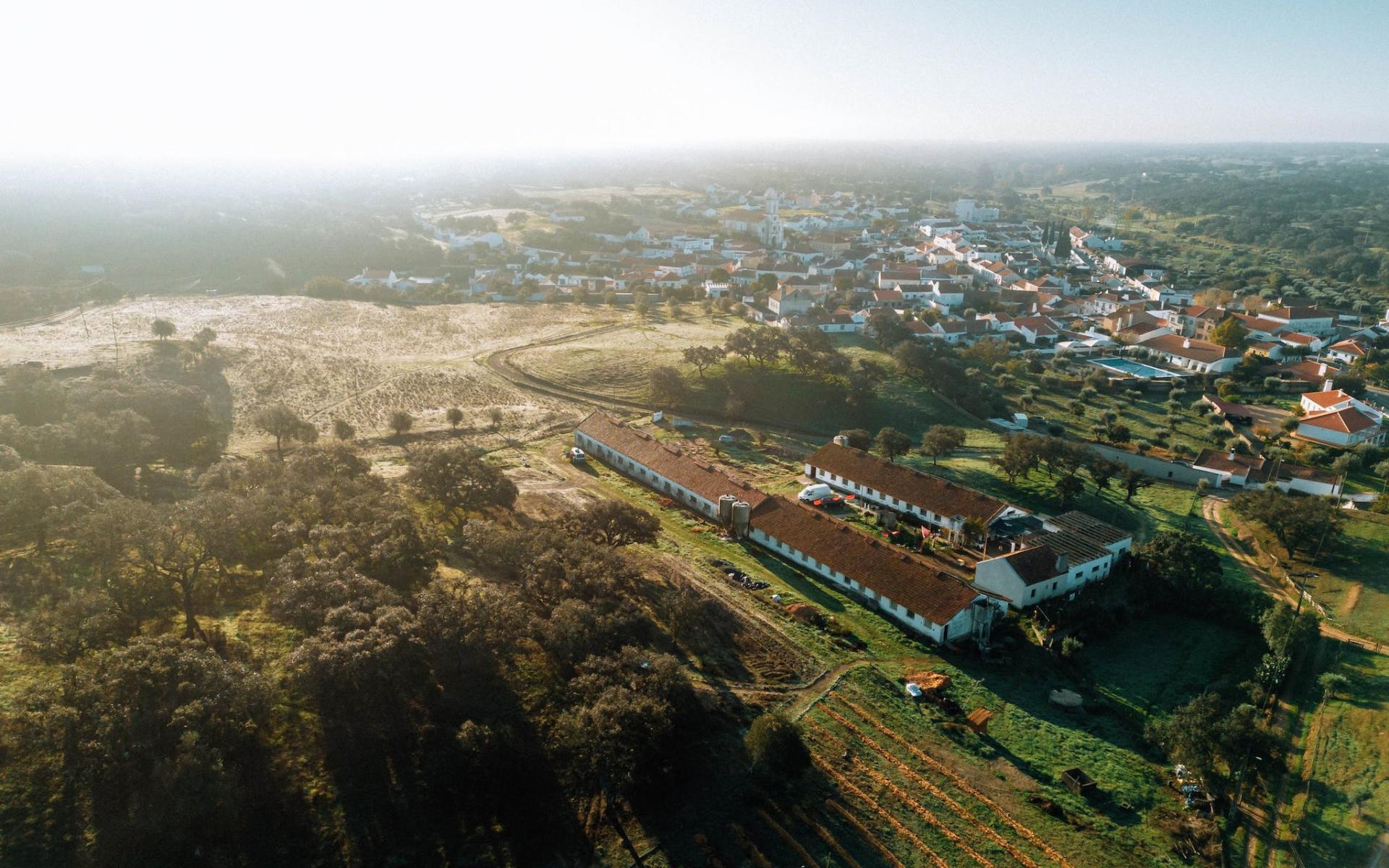traditional dream factory
Basic information
Project Title
traditional dream factory
Full project title
building a web3-powered regenerative Coliving community
Category
Reconnecting with nature
Project Description
A web3-powered model for a regenerative economy and deep connection, where doer-dreamers co-create a habitat where nature thrives.
Geographical Scope
Regional
Project Region
alentejo, yet it is a prototype to serve as a model for all of europe, Portugal
Urban or rural issues
It addresses urban-rural linkages
Physical or other transformations
It refers to a physical transformation of the built environment (hard investment)
EU Programme or fund
No
Description of the project
Summary
We pioneer a regenerative coliving model, fostering positive interactions among stakeholders, including nature, all life, and future generations. Traditional Dream Factory (TDF), located in a renovated 1972 poultry factory in Abela, Portugal, is committed to sustainable, equitable, and inclusive living, revitalizing a connection with nature.
Objectives:
Transition Farmers to Regenerative Practices: Support farmers in adopting regenerative practices, improving income, soil health, animal welfare, and living conditions.
Scale Regenerative Living: Inspire communities worldwide to replicate our model for collective action towards regenerative living.
Initiatives:
Harmony with Nature: Develop innovative technologies and practices to coexist harmoniously with nature, fostering sustainable living and reconnecting with the natural world.
Land Regeneration: Planting thousands of trees and regenerating 25 hectares of surrounding land.
Social Inclusion and Equity: Provide training and e-learning for all, covering decentralized governance, sustainable systems, and land regeneration.
Rural Hub: Attract global individuals interested in nature, permaculture, and sustainability in our coworking space for 30 people.
Food Production: Achieve self-sufficiency through community gardens and tree-planting events.
Sustainable Living Systems: Employ rainwater harvesting, helophyte filters, composting toilets, and natural building techniques.
Training Programs: Equip members with skills for sustainable living and reconnection with nature.
Inclusion ensures all members, regardless of abilities, are treated fairly, with access to opportunities and resources. We consider all stakeholders, including the unvoiced, like nature and future generations, when making decisions
Objectives:
Transition Farmers to Regenerative Practices: Support farmers in adopting regenerative practices, improving income, soil health, animal welfare, and living conditions.
Scale Regenerative Living: Inspire communities worldwide to replicate our model for collective action towards regenerative living.
Initiatives:
Harmony with Nature: Develop innovative technologies and practices to coexist harmoniously with nature, fostering sustainable living and reconnecting with the natural world.
Land Regeneration: Planting thousands of trees and regenerating 25 hectares of surrounding land.
Social Inclusion and Equity: Provide training and e-learning for all, covering decentralized governance, sustainable systems, and land regeneration.
Rural Hub: Attract global individuals interested in nature, permaculture, and sustainability in our coworking space for 30 people.
Food Production: Achieve self-sufficiency through community gardens and tree-planting events.
Sustainable Living Systems: Employ rainwater harvesting, helophyte filters, composting toilets, and natural building techniques.
Training Programs: Equip members with skills for sustainable living and reconnection with nature.
Inclusion ensures all members, regardless of abilities, are treated fairly, with access to opportunities and resources. We consider all stakeholders, including the unvoiced, like nature and future generations, when making decisions
Key objectives for sustainability
Create a regenerative living community that is designed to be in harmony with nature.
Develop and implement new technologies and practices that support sustainable living and reconnection with nature.
Promote social inclusion and equity by providing training and support to all members of the community.
TDF has made significant progress towards its sustainable objectives in a number of ways, including:
Planting thousands of trees and started regenerating 25 hectares of land.
Producing the majority of its own food through sustainable agriculture practices.
Building rainwater harvesting systems, a helophyte filter, and composting toilets.
Establishing training programs to help members of the community develop the skills they need to live sustainably.
TDF can be exemplary in the context of sustainability by:
Demonstrating that it is possible to create a thriving community that is also deeply sustainable.
Sharing its knowledge and experience with other communities around the world, so that they can replicate the TDF model.
Continuing to innovate and develop new sustainable technologies and practices.
Develop and implement new technologies and practices that support sustainable living and reconnection with nature.
Promote social inclusion and equity by providing training and support to all members of the community.
TDF has made significant progress towards its sustainable objectives in a number of ways, including:
Planting thousands of trees and started regenerating 25 hectares of land.
Producing the majority of its own food through sustainable agriculture practices.
Building rainwater harvesting systems, a helophyte filter, and composting toilets.
Establishing training programs to help members of the community develop the skills they need to live sustainably.
TDF can be exemplary in the context of sustainability by:
Demonstrating that it is possible to create a thriving community that is also deeply sustainable.
Sharing its knowledge and experience with other communities around the world, so that they can replicate the TDF model.
Continuing to innovate and develop new sustainable technologies and practices.
Key objectives for aesthetics and quality
a beautiful and inviting space where people can feel connected to nature and each other.
Design a community that is both functional and aesthetically pleasing.
Provide opportunities for people to learn and grow through cultural activities and events.
Using natural materials and sustainable design principles in the construction of the community. we use wood and local Cork for insulation.
Creating a variety of spaces for people to gather and connect, both indoors and outdoors. The community has a central courtyard, a number of gardens, and a variety of shared spaces for people to work, learn, and relax.
Offering a variety of cultural activities and events throughout the year. The community hosts workshops, talks, and other events on a variety of topics, including sustainable living, permaculture, and art.
By seamlessly integrating with nature and valuing aesthetics, we've created an environment that is not only ecologically friendly but also visually captivating.
we Involve the community in the design and planning process, so that everyone has a say in how the community looks and feels.
We built a website, an Elearning and a Custom Decentralized Booking platform (unique in its kind) at traditionaldreamfactory.com
The community is committed to using sustainable design principles and natural materials, and it offers a variety of spaces for people to gather and connect. TDF is also a cultural hub, hosting workshops, talks, and other events throughout the year.
Design a community that is both functional and aesthetically pleasing.
Provide opportunities for people to learn and grow through cultural activities and events.
Using natural materials and sustainable design principles in the construction of the community. we use wood and local Cork for insulation.
Creating a variety of spaces for people to gather and connect, both indoors and outdoors. The community has a central courtyard, a number of gardens, and a variety of shared spaces for people to work, learn, and relax.
Offering a variety of cultural activities and events throughout the year. The community hosts workshops, talks, and other events on a variety of topics, including sustainable living, permaculture, and art.
By seamlessly integrating with nature and valuing aesthetics, we've created an environment that is not only ecologically friendly but also visually captivating.
we Involve the community in the design and planning process, so that everyone has a say in how the community looks and feels.
We built a website, an Elearning and a Custom Decentralized Booking platform (unique in its kind) at traditionaldreamfactory.com
The community is committed to using sustainable design principles and natural materials, and it offers a variety of spaces for people to gather and connect. TDF is also a cultural hub, hosting workshops, talks, and other events throughout the year.
Key objectives for inclusion
Our key objectives for inclusion are:
to Create a community where everyone feels welcome and respected, regardless of their background, income, or abilities.
Ensure that everyone has access to the resources and opportunities they need to thrive.
Develop inclusive governing systems that give everyone a voice in the community's decision-making process.
Design the community in a way that is accessible to everyone, regardless of their abilities.
Explore new societal models that promote equity and social justice.
How TDF Has Met Its Inclusion Objectives:
The community has a diversity of members from all walks of life, and everyone is welcomed and valued.
Ensuring that everyone has access to the resources and opportunities they need to thrive.The community also has a number of shared spaces and resources, such as a community kitchen, a library, and a makerspace.
Developing inclusive governing systems. TDF has a decentralized governance system that gives everyone a voice in the community's decision-making process. The community has a number of committees that are responsible for different aspects of community life, and all members of the community are encouraged to participate.
Designing the community in a way that is accessible to everyone: most access points are at floor level.
TDF is exploring new societal models that promote equity and social justice. The community is experimenting with different ways to organize and manage itself, and it is always looking for new ways to create a more inclusive and equitable society.
TDF can be Examplary in this context by:
Sharing its knowledge and experience with other communities so that they can replicate the model
our inclusion practices:
a sliding scale membership fee to make the community accessible to people of all income levels. A token model to access the space for life
we make decisions through a consensus-based process to ensure that everyone's voice is heard.
to Create a community where everyone feels welcome and respected, regardless of their background, income, or abilities.
Ensure that everyone has access to the resources and opportunities they need to thrive.
Develop inclusive governing systems that give everyone a voice in the community's decision-making process.
Design the community in a way that is accessible to everyone, regardless of their abilities.
Explore new societal models that promote equity and social justice.
How TDF Has Met Its Inclusion Objectives:
The community has a diversity of members from all walks of life, and everyone is welcomed and valued.
Ensuring that everyone has access to the resources and opportunities they need to thrive.The community also has a number of shared spaces and resources, such as a community kitchen, a library, and a makerspace.
Developing inclusive governing systems. TDF has a decentralized governance system that gives everyone a voice in the community's decision-making process. The community has a number of committees that are responsible for different aspects of community life, and all members of the community are encouraged to participate.
Designing the community in a way that is accessible to everyone: most access points are at floor level.
TDF is exploring new societal models that promote equity and social justice. The community is experimenting with different ways to organize and manage itself, and it is always looking for new ways to create a more inclusive and equitable society.
TDF can be Examplary in this context by:
Sharing its knowledge and experience with other communities so that they can replicate the model
our inclusion practices:
a sliding scale membership fee to make the community accessible to people of all income levels. A token model to access the space for life
we make decisions through a consensus-based process to ensure that everyone's voice is heard.
Results in relation to category
Our co-living quarters will be home to 14 large suites with a living room & kitchen, 4 loft studios with a music production live-in studio, and a private house for families or friends. other outcomes are:
VEGGIE FARM (FOR 30+ PEOPLE)
OPEN COWORKING & STARLINK WIFI
6 VAN PARKING AREAS
10 GLAMPING ACCOMMODATIONS
FOOD FOREST + REFORESTATION
(W/ 2000+ TREES)
POP-UP EVENT SPACE
SAUNA
Over 30 regenerative events hosted
over 2000 people hosted , reconnecting to nature.
Direct beneficiaries of the TDF project include members of the community, who have benefited from the project's focus on sustainability, equity, and inclusion. its community-led decision-making process, and its tree planting and regeneration programs.
Indirect beneficiaries of the TDF project include people in other communities who are inspired by the project's success and who want to implement the same voting, fundraising and regenerative systems.
An increase in the community's economic self-reliance, as measured by the percentage of the community's income that is generated from within the community.
VEGGIE FARM (FOR 30+ PEOPLE)
OPEN COWORKING & STARLINK WIFI
6 VAN PARKING AREAS
10 GLAMPING ACCOMMODATIONS
FOOD FOREST + REFORESTATION
(W/ 2000+ TREES)
POP-UP EVENT SPACE
SAUNA
Over 30 regenerative events hosted
over 2000 people hosted , reconnecting to nature.
Direct beneficiaries of the TDF project include members of the community, who have benefited from the project's focus on sustainability, equity, and inclusion. its community-led decision-making process, and its tree planting and regeneration programs.
Indirect beneficiaries of the TDF project include people in other communities who are inspired by the project's success and who want to implement the same voting, fundraising and regenerative systems.
An increase in the community's economic self-reliance, as measured by the percentage of the community's income that is generated from within the community.
How Citizens benefit
We currently want to expand the project to regenerate 25 hectars to begin with, bringing back trees and species original from the area of Alentejo. The chain effect long term would be to create a microclimate that would be expanding and create water retention, and increase water through the regenerated land, which would benefit the whole community and surroundings, not just in terms of humans, but animals and life, in this area which has problems with water and fires. The expansion of local cork trees would prevent also fire from expanding in the town.
Citizens and civil society provide training and support to other members of the community on a variety of topics, such as sustainable living, permaculture, and natural building. There has been an integration with locals, through events, and tree planting actions.
Citizens have developed and implemented new projects, such as a community garden, a coworking space, and a makerspace, which can be used on request also by the citizens of Abela, the rural Town just a few minutes walk. TDF can bring cultural events, international connections, and even new job opportunities between innovation, sustainability and regeneration of the environment.
It is also essential to building a strong sense of community and ownership among members and civil society. TDF wants to be a prototype for regenerative society to be replicated in all of europe to the world , changing the economy and lifestyle to a more regenerative model.
Citizens and civil society provide training and support to other members of the community on a variety of topics, such as sustainable living, permaculture, and natural building. There has been an integration with locals, through events, and tree planting actions.
Citizens have developed and implemented new projects, such as a community garden, a coworking space, and a makerspace, which can be used on request also by the citizens of Abela, the rural Town just a few minutes walk. TDF can bring cultural events, international connections, and even new job opportunities between innovation, sustainability and regeneration of the environment.
It is also essential to building a strong sense of community and ownership among members and civil society. TDF wants to be a prototype for regenerative society to be replicated in all of europe to the world , changing the economy and lifestyle to a more regenerative model.
Physical or other transformations
It refers to a physical transformation of the built environment (hard investment)
Innovative character
Focus on regeneration: The TDF project is focused on regenerating the natural environment and the social fabric of the community. It is planting trees, restoring ecosystems, and building relationships with local communities. It is also developing new economic models and social structures that promote sustainability and equity.
Decentralized Booking platform and Governance.
The TDF community is developing a new economic model that is based on local currency, community barter, and gift economies.
Creating a new social structure that is based on mutual aid, consensus decision-making, and participatory democracy
The TDF community is using a variety of innovative technologies and practices to reduce its environmental impact, such as rainwater harvesting, composting toilets, and solar power.
It is innovative in a number of ways, when compared to mainstream actions in the field of sustainable community development. It takes a holistic and integrated approach, it is committed to equity and inclusion, and it is focused on regeneration. The TDF project is a model for a new approach to sustainable community development, and it is an inspiration for other communities that are looking to create a more sustainable, equitable, and inclusive future.
Holistic and integrated approach: The TDF project takes a holistic and integrated approach to sustainable community development. It considers all aspects of community life, from food and water systems to housing . It also draws on a variety of disciplines and knowledge fields, including architecture, engineering, permaculture, social science, and sustainable economics.
Decentralized Booking platform and Governance.
The TDF community is developing a new economic model that is based on local currency, community barter, and gift economies.
Creating a new social structure that is based on mutual aid, consensus decision-making, and participatory democracy
The TDF community is using a variety of innovative technologies and practices to reduce its environmental impact, such as rainwater harvesting, composting toilets, and solar power.
It is innovative in a number of ways, when compared to mainstream actions in the field of sustainable community development. It takes a holistic and integrated approach, it is committed to equity and inclusion, and it is focused on regeneration. The TDF project is a model for a new approach to sustainable community development, and it is an inspiration for other communities that are looking to create a more sustainable, equitable, and inclusive future.
Holistic and integrated approach: The TDF project takes a holistic and integrated approach to sustainable community development. It considers all aspects of community life, from food and water systems to housing . It also draws on a variety of disciplines and knowledge fields, including architecture, engineering, permaculture, social science, and sustainable economics.
Disciplines/knowledge reflected
TDF has a variety of disciplines and knowledge fields in its design and implementation, including:
Architecture and engineering
Permaculture and ecological design
Art and design
Law
token economics
community management
software engineering.
education
Representatives of these different fields interacted with each other in a variety of ways, including:
Collaborative workshops, working groups, Monthly community meetings, Online forums and discussion groups
We got expertise, also from our members of a variety of disciplines to create a community that is sustainable, equitable, and inclusive.
different fields , categorized as circles , communicate with each other most of the time, also through a coordination that helps connecting dots between different fields such as engineering, with permaculture and architecture, have been working together from the creation of an helophyte filter, to much more.
Educators worked with artists and designers to develop educational programs that would help community members learn about sustainable living and permaculture.
Architects worked with permaculture experts to design buildings that would be energy-efficient and integrated with the natural environment.
The interaction between representatives of different fields helped to ensure that the TDF project was more than just a collection of individual projects. It was a holistic and integrated effort to create a sustainable, equitable, and inclusive community.
Architecture and engineering
Permaculture and ecological design
Art and design
Law
token economics
community management
software engineering.
education
Representatives of these different fields interacted with each other in a variety of ways, including:
Collaborative workshops, working groups, Monthly community meetings, Online forums and discussion groups
We got expertise, also from our members of a variety of disciplines to create a community that is sustainable, equitable, and inclusive.
different fields , categorized as circles , communicate with each other most of the time, also through a coordination that helps connecting dots between different fields such as engineering, with permaculture and architecture, have been working together from the creation of an helophyte filter, to much more.
Educators worked with artists and designers to develop educational programs that would help community members learn about sustainable living and permaculture.
Architects worked with permaculture experts to design buildings that would be energy-efficient and integrated with the natural environment.
The interaction between representatives of different fields helped to ensure that the TDF project was more than just a collection of individual projects. It was a holistic and integrated effort to create a sustainable, equitable, and inclusive community.
Methodology used
At TDF we envision our desire for the future about the land , and the ecosystem, how people and communities can reconnect to nature and regenerate the environment, while living an authentic life and being engaged in a new economic and living model.
As to decide where to focus our steps every member has the right to vote for next decisions and goals for the community. We take active part of operations also by joining circles about different disciplines, or by coordination in rotation with the seasons as stewards.
The Traditional Dream Factory (TDF) project uses a regenerative design methodology. Regenerative design is a holistic and integrated approach to design that aims to create systems that are restorative and resilient. It is based on the principles of nature and the understanding that all systems are interconnected.
Tdf aldo uses Permaculture design principles as a set of guidelines for designing sustainable systems. These principles are based on the observation of natural systems and the understanding of how they work.
As to decide where to focus our steps every member has the right to vote for next decisions and goals for the community. We take active part of operations also by joining circles about different disciplines, or by coordination in rotation with the seasons as stewards.
The Traditional Dream Factory (TDF) project uses a regenerative design methodology. Regenerative design is a holistic and integrated approach to design that aims to create systems that are restorative and resilient. It is based on the principles of nature and the understanding that all systems are interconnected.
Tdf aldo uses Permaculture design principles as a set of guidelines for designing sustainable systems. These principles are based on the observation of natural systems and the understanding of how they work.
How stakeholders are engaged
People came to traditional dream factory from all over portugal and europe, in fact our base of over 50 members has seen over a thousand visitors.
Our members , from Portugal and all of Europe have been involved from the beginning.
Traditional Dream Factory is also a DAO (decentralized autonomous organization) which means that most main decisions are taken through decentralized voting systems to involve all the community from design to implementation and the direction to take.
Residents of the village of Abela, Portugal, where the TDF project is located: Residents were involved in the design and planning process through public meetings and workshops. They also provided feedback on the project's plans and progress.
Organizations: organizations provided support to the TDF project . They also partnered with the TDF project to provide training and support to community members through events.
People came to traditional dream factory from all over portugal and europe, in fact our base of over 50 members has seen over a thousand visitors.
Our members , from Portugal and all of Europe have been involved from the beginning.
Traditional Dream Factory is also a DAO (decentralized autonomous organization) which means that most main decisions are taken through decentralized voting systems to involve all the community from design to implementation and the direction to take.
Residents of the village of Abela, Portugal, where the TDF project is located: Residents were involved in the design and planning process through public meetings and workshops. They also provided feedback on the project's plans and progress.
Organizations: organizations provided support to the TDF project . They also partnered with the TDF project to provide training and support to community members through events.
People came to traditional dream factory from all over portugal and europe, in fact our base of over 50 members has seen over a thousand visitors.
Global challenges
we want to address global challenges by providing local solutions:
TDF is part of the OASA network - transforming ownership into stewardship. The TDF project is bound by the Regenerative Land Stewardship Principles set forth by OASA. By accessing TDF lands, our members and visitors must abide by our regenerative ethos. OASA is on a bold mission to conserve 100.000 ha of land globally - and TDF is its first prototype in utilising real estate as a vehicle for ecological restoration.
Biodiversity loss, a big Problem for Alentejo Area: The TDF project is working to restore and protect local ecosystems. This includes planting trees, creating wildlife habitats, and "water harvesting" These initiatives help to protect biodiversity and build resilience to climate change. also prevent from fires in the area. we want to help farmers with regenerative practices together with technological and decentralized innovation to regenerate and reduce carbon emissions.
Inequality: The TDF project is committed to creating a more equitable and inclusive community. This is reflected in the project's focus on Cohousing, community-led decision-making, and mutual aid.
Climate change: The TDF project is working to reduce its environmental impact and promote sustainability through a variety of initiatives, such as rainwater harvesting, solar power, and permaculture agriculture. These initiatives help to reduce greenhouse gas emissions and build resilience to the effects of climate change.
TDF is part of the OASA network - transforming ownership into stewardship. The TDF project is bound by the Regenerative Land Stewardship Principles set forth by OASA. By accessing TDF lands, our members and visitors must abide by our regenerative ethos. OASA is on a bold mission to conserve 100.000 ha of land globally - and TDF is its first prototype in utilising real estate as a vehicle for ecological restoration.
Biodiversity loss, a big Problem for Alentejo Area: The TDF project is working to restore and protect local ecosystems. This includes planting trees, creating wildlife habitats, and "water harvesting" These initiatives help to protect biodiversity and build resilience to climate change. also prevent from fires in the area. we want to help farmers with regenerative practices together with technological and decentralized innovation to regenerate and reduce carbon emissions.
Inequality: The TDF project is committed to creating a more equitable and inclusive community. This is reflected in the project's focus on Cohousing, community-led decision-making, and mutual aid.
Climate change: The TDF project is working to reduce its environmental impact and promote sustainability through a variety of initiatives, such as rainwater harvesting, solar power, and permaculture agriculture. These initiatives help to reduce greenhouse gas emissions and build resilience to the effects of climate change.
Learning transferred to other parties
TDF wants to act as a model for other communities and the systems developed so far with OASA are the first of its kind. The decentralized booking platform and the legal footprint , which took over a year to develop are going to be accessible for any other regenerative community out there.
The Elearning platform also is made to have practices, processes and methodologies replicated.
TDF is built also to give communities n rural areas tools to develop a project to restore its natural ecosystems.
The Elearning platform also is made to have practices, processes and methodologies replicated.
TDF is built also to give communities n rural areas tools to develop a project to restore its natural ecosystems.
Keywords
regenerative economy
decentralization
community
innovation
training programs

